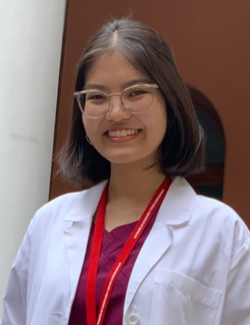By Gabriela Leon Ung
It was a regular morning. Get up, quickly shower, and hurriedly brew a hot cup of coffee that would end up cold by the time I arrived in the student parking lot on my first day of the internal medicine clerkship. We were all standing there, greeting our classmates, dressed up in white—some with breadcrumbs still in the corner of their mouths and others with various extravagant pins on their white coats showing off the student associations they were a part of. We were all excited and scared at the same time, eager to finally use our essential tools as future doctors: our hands, eyes, and ears. Oh, and the fancy stethoscope we all got as a gift for entering medical school.
It was almost 7:00 am, almost show time. My group arrived to our respective ward: the women's internal medicine ward. I introduced myself to the attending; she warmly greeted us and proceeded to introduce us to the patients. There were various patients with different conditions and of different ages, some warmer than others, some with specks of hope in their eyes and others who were deeply sleeping. We approached bed by bed, case by case. At the end of the introduction, the attending assigned each one of us a patient to study and follow during our 3-week-long clinical rotation. Spoiler alert: I luckily got assigned the patient I was hoping to get.
I present to you Ms. S, a 21-year-old woman whose age was close to mine. She had a history of systemic lupus erythematosus and pulmonary tuberculosis. Ms. S lay on her bed comfortably and shyly smiled at me while I walked toward her and presented myself. I proceeded to explain what I would be doing for the upcoming week: a thorough physical exam and writing a detailed clinical history, which roughly translated to spending a lot of time together. Ms. S happily agreed. For the next couple of days, I started learning a lot about her and her case. She had arrived at the hospital with high fever, arthralgia, lower-extremity edema, chest pain, and dyspnea. While taking her vital signs, I noticed that she seemed to have difficulty breathing and sometimes even gasped for air. She told me, “That's the usual way I breathe.” Apparently, she didn't feel sick at all.
During the next day, it was time to explore her cardiopulmonary system. She had palpitations and an enlarged heart by inspection and palpation of her thorax. I also noticed a probably elevated JVP. I proceeded to auscultate her heart, trying to focus solely on the heart sounds. I was astonished to hear my first heart murmur: a gotten-out-of-textbook mitral insufficiency murmur. I gasped in astonishment, and Ms. S looked at me with confused eyes. I explained to her what I was listening to and that maybe that was causing her recent dyspnea. I'm not sure whether she was scared at that moment; however, she then replied, “I've felt my heart like this for as long as I remember. I feel all right.”
I would always talk with Ms. S about her life, trying to lift up the mood and connect with my patient. Since the beginning of my medical school journey, I had a mindset of treating patients as humanly as possible by striking up a conversation every now and then and cracking jokes in between. I knew she stopped taking her tuberculosis and lupus medications about 2 years ago because she couldn't afford them. I knew her grandma was all she had left. I knew she had a boyfriend who visited and brought her cookies every other day. She was just a young woman whose priorities were attuned to youth than health.
During my last week in the ward, Ms. S was scheduled for an echocardiogram that showed moderate left ventricular dysfunction and severe mitral insufficiency. At this point, I was worried about the severity of her condition and how oblivious she seemed about it. We asked for a cardiology consultation that was scheduled for the upcoming days. The cardiologist arrived with an intern and two students. He evaluated Ms. S's case and proceeded to prescribe a beta-blocker and ordered her to be transferred to the cardiology ward with an indication for an expensive mitral valve replacement surgery. A surgery she needed to improve her worsening heart condition, and a surgery she probably never got.
Most times, as medical students, we get to see patients for a couple of weeks and never end up really knowing how their case ends—we get a brief taste of how real and difficult these situations can become. I couldn't stop comparing how we were both so similar in age but in such very different situations in life. What would have happened if she hadn't stopped taking her medications 2 years ago? Was she able to afford the surgery? Did she recover? After this clerkship was over, I realized that we have the extraordinary honor to be there during people's weakest moments. Even if it is for a brief moment, we get the chance to extend our hand and do our best to help a human's life both physically and mentally. It takes a toll on all of us, but it's the beautiful human side of this orthodoxy-driven career that makes it stand out from everything else. It shows there's an impact in what we can achieve from it, and I'm extremely grateful that it teaches me how to use my heart and brain—everything … all at once.

Gabriela Leon Ung
Universidad Latina de Panamá
(Latin University of Panama)
Graduating Class of 2021
Back to the July 2021 issue of ACP IMpact

